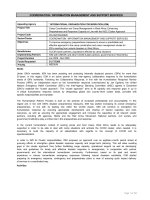Product information management for mass customization connecting customer front office and back office for fast and efficient customization
Bạn đang xem bản rút gọn của tài liệu. Xem và tải ngay bản đầy đủ của tài liệu tại đây (2.33 MB, 242 trang )
Product Information
Management for Mass
Customization
Connecting Customer, Front-office and
Back-office for Fast and Efficient Customization
Cipriano Forza and Fabrizio Salvador
Product Information Management for Mass
Customization
This page intentionally left blank
Product Information
Management for Mass
Customization
Connecting Customer, Front-office and
Back-office for Fast and Efficient
Customization
Cipriano Forza and Fabrizio Salvador
© Cipriano Forza and Fabrizio Salvador 2006
All rights reserved. No reproduction, copy or transmission of this
publication may be made without written permission.
No paragraph of this publication may be reproduced, copied or transmitted
save with written permission or in accordance with the provisions of the
Copyright, Designs and Patents Act 1988, or under the terms of any licence
permitting limited copying issued by the Copyright Licensing Agency, 90
Tottenham Court Road, London W1T 4LP.
Any person who does any unauthorized act in relation to this publication
may be liable to criminal prosecution and civil claims for damages.
The authors have asserted their rights to be identified as the authors
of this work in accordance with the Copyright, Designs and
Patents Act 1988.
First published 2006 by
PALGRAVE MACMILLAN
Houndmills, Basingstoke, Hampshire RG21 6XS and
175 Fifth Avenue, New York, N.Y. 10010
Companies and representatives throughout the world
PALGRAVE MACMILLAN is the global academic imprint of the Palgrave
Macmillan division of St. Martin’s Press, LLC and of Palgrave Macmillan Ltd.
Macmillan® is a registered trademark in the United States, United Kingdom
and other countries. Palgrave is a registered trademark in the European
Union and other countries.
ISBN 13: 978–0–230–00682–9 hardback
ISBN 10: 0–230–00682–5
hardback
This book is printed on paper suitable for recycling and made from fully
managed and sustained forest sources.
A catalogue record for this book is available from the British Library.
Library of Congress Cataloging-in-Publication Data
Forza, Cipriano, 1962–
Product information management for mass customization : connecting
customer, front-office, and back-office for fast and efficient customization
/ by Cipriano Forza and Fabrizio Salvador
p. cm.
Includes bibliographical references and index.
ISBN 0–230–00682–5 (alk. paper)
1. Product management. I. Salvador, Fabrizio, 1971– II. Title.
HF5415.15.F67 2006
658.5Ј1–dc22
10
15
9
14
8
13
7
12
6
11
2006043218
5
10
4
09
3
08
2
07
1
06
Printed and bound in Great Britain by
Antony Rowe Ltd, Chippenham and Eastbourne
To Lara and Nicoletta,
our loving wives and
patient companions in the
journey of life
This page intentionally left blank
Contents
List of Figures
x
List of Tables
xiv
List of Cases
xv
Preface
xvii
Reader’s Guide
xix
Part I: Product Configuration
1 Product Configuration: a New Approach to More
Efficient Product Customization
1.1 The trend towards product proliferation
1.2 Search for an ‘efficient’ variety
1.3 Variety or customization?
1.4 Towards efficient customization: product
configuration
12
2 Configuration Process and Configurable Products
16
2.1
2.2
2.3
2.4
3
3
7
9
Product configuration process
Configuration process sub-tasks
‘Configurable product’ characteristics
Degrees of configuration
16
21
23
29
3 Traditional Approaches to Configuration
32
3.1 Non-structured approaches
3.2 Structured approaches to collecting specifications
3.3 Structured approaches to collecting and checking
specifications
3.4 Dynamic approaches to product configuration
3.5 Beyond traditional approaches
32
35
38
44
47
Part II: Product Configuration Systems
4 Configuration Systems Architecture
4.1
4.2
4.3
4.4
Product configurators architecture
From configurator to configuration system
Moderately automated configuration systems
Highly automated configuration systems
vii
51
51
55
57
59
viii Contents
4.5 Totally automated configuration systems
4.6 How to determine the optimal degree of automation
4.7 Configurators, selectors and meta-configurators
5 Commercial Product Modelling
5.1
5.2
5.3
5.4
5.5
5.6
5.7
Cognitive complexity and configurable products
Describing the product
Limiting options
Communicating value
Structuring the process of interaction with the customer
Interaction and learning
Putting everything together
6 Technical Product Modelling
6.1
6.2
6.3
6.4
6.5
6.6
6.7
6.8
Technical description of configurable products
Add-delete bill of materials
Modular bills
Common practice
Technical model and generic bills of material
Unification of product views in the technical model
Criteria for defining the technical model
Links with sales dialogue
7 Other Product Models
7.1
7.2
7.3
7.4
7.5
Codes
Model used to determine cost
Models used for determining product price
Geometric and graphic models
Other models
61
63
63
67
67
71
74
77
79
82
84
86
86
90
92
94
96
103
105
108
111
111
116
119
121
124
Part III: Selection and Implementation of a
Configurator
8 Configurators and Management Information
Systems
8.1 Configuration system and Manufacturing Planning and
Control System
8.2 Configuration systems and Product Data Management
systems
8.3 Configuration systems and Customer Relationship
Management
127
127
131
134
Contents ix
9 Selecting a Product Configurator
9.1
9.2
9.3
9.4
9.5
9.6
The configurator: defining expected benefits and
requirements
Basic functions
Special functions
Configurator technology
Modelling approaches
Interaction with the user
10 Implementing a Configuration System
10.1
10.2
10.3
10.4
10.5
10.6
10.7
10.8
A reference process
Preliminary analysis: do we really need it?
Macro-analysis: to what extent do we need it?
Micro-analysis: evaluating implementation
alternatives and costs
System design and implementation planning
System implementation and launching
The elements of success
Project ‘killers’
141
141
143
145
148
150
156
160
160
162
164
167
171
174
176
178
Part IV: Operational and Organizational Implications
of a Configuration System
11 A Comprehensive View: the Sideco Case Study
183
11.1 Product and company context
11.2 The original configuration process
11.3 The solution: a software to support product
configuration
11.4 Product modelling
11.5 The new configuration process
11.6 A special case?
183
186
188
188
189
192
12 Configurational Approach: Aligning Product,
Processes and Organization Systems
12.1
12.2
12.3
12.4
12.5
12.6
Overcoming the ‘delay syndrome’ and sluggish red-tape
Changes in roles and responsibilities
A new knowledge management process
Different order acquisition and fulfilment processes
Inter-company coordination
Configurational approach
194
197
198
200
202
204
Bibliography
207
Index
215
List of Figures
Figure 1.1
Figure 1.2
Figure 1.3
Figure 1.4
Figure 1.5
Figure 2.1
Figure 2.2
Figure 2.3
Figure 2.4
Figure 2.5
Figure 2.6
Figure 2.7
Figure 2.8
Figure 2.9
Figure 3.1
Figure 3.2
Figure 3.3
Figure 3.4
Figure 3.5
Figure 3.6
Figure 3.7
Increase in product variety, reported by American
enterprises management
Different paths towards overcoming trade-off
between operational performance and product
variety
Generic sequence of operational activities for a
manufacturing company
Scope of product configuration
Scope of product configuration
From customer needs to a commercial description
of the product
From commercial description to product
documentation
Schematic representation of a generic product
configuration
Functions of moto-variator components and
accessories
Architecture based on the combination of different
components
Interdependence of technical characteristics
of a shirt
Example of technical parameters for a
‘made to measure’ shirt
Product space and commercial configuration
Degrees of product configuration
Specifications that can be customized in a voltage
transformer
Non-structured information of a transformer
specifications and sales conditions
Form for the customization of a suit
Double entry table for finding product families
(gas pressure regulators)
Double entry diagram for a volumetric pump
Pure customization due to lack of support for
the technical configuration process
DEC configuration system
x
4
9
10
10
13
18
20
21
24
25
26
27
29
30
34
35
38
39
41
44
46
List of Figures xi
Figure 4.1
Figure 4.2
Logical architecture of a product configurator
Logical architecture of a product configuration
system
Figure 4.3 Configuration system with weak automation
Figure 4.4 Highly automated configuration system
(fully automated commercial configuration)
Figure 4.5 Highly automated configuration system
(fully automated technical configuration)
Figure 4.6 Totally automated configuration system
Figure 4.7 Factors that influence the degree of optimal
automation in a configuration system
Figure 4.8 Product selector for low voltage electrical fittings
Figure 4.9 Meta-configurator of bridges
Figure 4.10 Application field of selectors, configurators and
meta-configurators in relation to the customization
strategy of the company
Figure 5.1 Product descriptions with different degrees of
abstraction
Figure 5.2 Commercial description of a PC with a high
level of abstraction
Figure 5.3 Commercial description of a product with a low
level of abstraction
Figure 5.4 Simplification of the commercial model by limiting
the options
Figure 5.5 Fundamental activities to communicate the value
of the variety offered by the company
Figure 5.6 Communication of functions related to three hard
drive variants
Figure 5.7 Structure of the sales dialogue
Figure 5.8 Attributes for the configuration of a truck
Figure 5.9 Interdependence between parameters
Figure 5.10 Modifications of some components due to
the specification ‘maximum comfort level’
Figure 5.11 Integrated scheme for a conceptual design of the
commercial model
Figure 6.1 Information needed to describe each product variant
Figure 6.2 Different views of product structure
Figure 6.3 Alternative approaches to handling product
documentation
Figure 6.4 Add-delete approach used to describe product
variants
54
56
57
59
60
62
63
64
65
66
71
72
73
75
78
79
81
83
84
84
85
87
88
89
90
xii List of Figures
Figure 6.5
Figure 6.6
Figure 6.7
Figure 6.8
Figure 6.9
Figure 6.10
Figure 6.11
Figure 6.12
Figure 6.13
Figure 6.14
Figure 6.15
Figure 6.16
Figure 6.17
Figure 7.1
Figure 7.2
Figure 7.3
Figure 7.4
Figure 7.5
Figure 7.6
Figure 7.7
Figure 7.8
Figure 7.9
Figure 7.10
Figure 7.11
Figure 7.12
Figure 8.1
Figure 8.2
Figure 8.3
Figure 10.1
Bills of four microwave oven variants
(only level 0 and 1)
Modular bills for a microwave oven
Effects of interdependent options on modular bills
Elaboration of a bill of materials after contract with
the customer
Generic bill of materials
Presence of types of components at levels lower
than the first one
Dynamic generation of new real elements in a bill
of materials
Schematic technical model for normalized
mould-bases
Types of information present in the generic bill
Proposal of generic bill of materials for Silentwhistle
Example of a description of technical information
focused on physical subsets
Example of a description of technical information
focused on performances
Sales dialogue-technical model graphic
representation
Polycode
Hierarchical code
Logical structure for code generation
Generation of the polycode in the product code
Product cost obtained by ‘summing up’ the cost
included in the bill of materials
Cost of a cycle element: dynamic estimation
Costs included in a real bill of materials
Price definition by means of answers gathered
in the sales dialogue
Generation of graphic representations
Geometric model of a configurable table
Prototype of configurator for A340 cabins
Antenna pattern configurator
Configurator and Manufacturing Planning and
Control System
Configurator and PDM
Configurator and CRM
Different steps in the implementation process of a
configurator
92
93
93
95
99
101
102
103
104
105
106
107
109
112
113
115
115
117
118
119
120
121
123
123
124
128
131
135
160
List of Figures xiii
Figure 10.2 Preliminary analysis: aims, activities and
deliverables
Figure 10.3 Macro-analysis: aims, activities and deliverables
Figure 10.4 Micro-analysis: aims, activities and deliverables
Figure 10.5 System design and implementation planning: aims,
activities and deliverables
Figure 10.6 System implementation and launch: aims, activities
and deliverables
Figure 11.1 An example of mould-block
Figure 11.2 Examples of different mould-block configurations
Figure 11.3 The configuration process before the introduction
of a product configurator
Figure 11.4 Graphic output of the configuration system
Figure 11.5 The configuration process after introducing the
product configurator
Figure 12.1 Delay syndrome dynamics
Figure 12.2 Cycle time expansion while checking the order
Figure 12.3 Changes in roles and responsibilities
Figure 12.4 Modelling process
Figure 12.5 Different processes for configurable and special
motors
Figure 12.6 Enterprise-supplier coordination through
technical model
Figure 12.7 An integrative model of the technical and
organizational actions needed to efficiently offer
customization through product configuration
163
165
168
172
175
184
185
186
190
192
195
196
197
199
202
203
205
List of Tables
Table 1.1 Trend in product variety (no. of models) for some
products in the USA
Table 3.1 Advantages and disadvantages of non-structured
approaches to product configuration
Table 3.2 Advantages and disadvantages of specialized forms
in product configuration
Table 3.3 Double entry table for checking the compatibility
of the choices made by the customer
Table 3.4 Multiple entry table
Table 3.5 Advantages and disadvantages of tables and diagrams
for product configuration
Table 3.6 Advantages and disadvantages of special purpose
configuration software
Table 5:1 Representation of the offer in terms of attributes or
in terms of alternatives and cognitive complexity
Table 6.1 Analysis of errors in a bill of materials for TEFC
electric motors
Table 9.1 Basic functions of modern configurators
Table 9.2 Special functions
Table 9.3 Configurator technology
Table 9.4 Modelling approaches
Table 9.5 Interaction with the user
xiv
4
33
36
40
42
43
46
69
97
143
145
148
151
157
List of Cases
2.1
2.2
3.1
3.2
3.3
4.1
4.2
4.3
4.4
4.5
4.6
5.1
5.2
5.3
5.4
5.5
6.1
6.2
6.3
6.4
6.5
7.1
7.2
An example of a configurable product: a moto-variator
An example of a configurable product: a shirt
Configuration of an electric transformer using loose sheets
Configuring a traditional suit using pre-printed forms
Configuring a microcomputer: the digital case
Configuration with weak automation for the textile
industry
Configuration with strong automation of voltage
transformers
Configuration with strong automation for numerical
control milling tools
Configuration with total automation for hydro-massage
bathtubs
Product selector for low voltage electrical fittings
Meta-configurator of prefabricated bridges
Selection of a sofa by alternatives or by attributes:
an experiment
An example of different product descriptions: the case of
computers
Limiting the options available in the commercial
configuration of a gas regulator
Communicating the value of the product options:
the case of Dell Computers
Interactive learning of the interdependencies between
different characteristics of a truck
Add-delete approach for the configuration of industrial
vehicles variants
Modular bills for microwave oven: an example
Add-delete approach for the configuration of electric
motors
Generic bills of materials for a normalized mould-base
Silentwhistle technical model
Determining the cost of a configurable product:
the case of office chairs
Generation of graphic outputs as a result of configuration:
the case of a furniture factory
xv
24
26
33
37
45
58
59
61
62
64
65
69
72
76
78
83
91
92
96
102
105
118
122
xvi List of Cases
8.1 Linking configurator and MPCS in the ERP: an example
12.1 The lack of system documentation: the case of a wood
working machinery producer
12.2 Configurable and special products: the case of electric
motors
12.3 Buyer–supplier coordination and configuration system:
the case of dashboards for industrial trucks
129
200
201
203
Preface
The history of product configuration started several years ago, when the
Digital Equipment Corporation gathered a team of ‘knowledge engineers’
with an apparently impossible mission: to create a system capable of
helping salespeople in the complex definition of microcomputer PDP
specifications, and of supporting production technicians in the definition
of the components needed to satisfy such specifications. The problem
arose from the fact that PDP microcomputers could be built in millions of
different variants, taking into account hundreds of technical constraints.
Consequently, the Digital Equipment Corporation was forced to invest
considerable resources in customizing its products. The experience of this
company was a pioneering attempt to gather and formalize the necessary
knowledge to customize a product. The contribution of these pioneers, as
usual, only produced widespread results a number of years later. Cisco
Systems and Dell Computers successfully sold their configurable products
thanks to those first ‘knowledge engineers’.
Formalizing the knowledge to customize a product, transferring such
knowledge into a product configurator, and realigning the organization to exploit the capability of such product configurator are very
complex activities. Unfortunately, no guidelines exist as for the appropriate execution of these activities. On the one hand, those companies
which have succeeded in implementing a product configuration system are unwilling to disclose their successful ‘recipes,’ as they try to
protect their competitive advantage. On the other hand, most of the
texts dealing with this subject do not tender advice to managers, as
most texts are typically addressing an academic or overly specialized
audience. Last but not least, extant literature on product configuration
is dominated by a technocratic view of these technologies, and fails to
recognise the organizational concerns associated with the implementation of a product configuration system.
Whilst there are only a few companies that have a clear idea of how
to face the problem of product configuration, there are many others in
great need of answers, of the know-how needed to tackle the obstacles.
Unfortunately, the only easily accessible source of information comes
from software houses which sell product configurators. It is evident that
this information is focused on commercial purposes and does not follow the systematic and objective criteria which are typical features of
xvii
xviii Preface
scientific works. This volume aims at formalizing the principles according to which a company may offer customized products, following
product configuration approaches. In addition, this work introduces a
type of language to describe this particular subject, establishing the
bases for scientific management research in this topic. Finally, it discuses the mechanisms through which principles are translated into operational performances, encouraging the company to reach the goal of
‘efficient customization’.
From a methodological point of view, this work is the synthesis of
research that lasted for four years. Case studies and interviews with
configuration system programmers, system engineers, managers, executives and consultants allowed a holistic approach to product configuration problems. Research-intervention activities helped us to immediately understand the real problems related to the adoption of this
approach. Finally, a study of a vast number of enterprises that offer
product customization persuaded us of the extent and relevance of the
problems analysed in this volume. We hope the answers this book supplies will be equally appreciated.
The results of this research cannot be attributed solely to the authors:
a good number of other people contributed to clarifying the subject.
There are too many to mention individually, but we offer our heartfelt
thanks to all those who have offered their valuable experience and
knowledge.
Financial support for this book was granted by the Spanish Ministry
of Science and Education, National R&D Plan, (Ministerio de Ciencia y
Educación, Plan Nacional de I+D), Project #SEJ-2004-08176-C02-01.
Cipriano Forza
Fabrizio Salvador
Reader’s Guide
There are twelve chapters in this book divided into four parts. Part I
introduces the subject of product configuration. In particular, Chapter
1 highlights the field where the concept of product configuration is
applicable. Chapter 2 defines the process of product configuration and
configurable products. Finally, in Chapter 3 traditional approaches to
product configuration are discussed, describing their advantages and
disadvantages.
Part II illustrates the structures and functional mechanisms of configuration systems supported by product configurators. Chapter 4 explains
how to integrate organization and information system, distinguishing
situations characterized by different degrees of automation. Chapters 5
and 6 analyse in detail the logic applied to formalize the knowledge
needed to carry out product configuration, from the commercial and
technical-production points of view respectively. Chapter 7 offers a general view of the models underlying the automatic generation of codes,
costs, prices and graphic outputs for configurable products.
Part III deals with the selection of a product configurator, its implementation and links with other parts of the company’s information system. In particular, Chapter 8 analyses how the configurator interfaces
with the production planning system and the advanced information
system, especially useful in the presence of customized products, such
as Product Data Management and Customer Relationship Management.
Chapter 9 offers a detailed picture of the various aspects which differentiate product configurators while Chapter 10 presents a structured
approach to the implementation of the product configuration system.
Finally, Part IV analyses the impact of configuration systems on the
company as a whole. Chapter 11 presents a detailed case study of an
enterprise that successfully implemented a configuration system,
describing the changes in operational processes and in the related services. Chapter 12 describes how the implementation of a configuration
system affects the whole organization, and how ‘customizing using
configuration’ requires an integrated action on the product, the organization and the information systems that support product knowledge
management.
xix
xx Reader’s Guide
How to read this book
This book is addressed to different kinds of readers. According to the
type of reader, there are various itineraries to follow while reading this
work, that will satisfy specific cognitive needs with the least possible
effort.
• University students: Engineering or Business Management students,
who are attending a special course on product configuration or on
product variety management, can read this book following the order
of the table of contents. To those who study Engineering and are
attending, for example, a basic course on Management, we suggest
reading Chapters 1, 2, 3, 11 and 12 as complements to basic managerial knowledge.
• Directors, managers and consultants: this category of readers
includes people with different roles. A company director will find it
useful to read Chapters 1, 2, 4, 10, 11 and 12. Managers of different
areas may be interested in reading more specialized subjects, such as
Chapters 5, 6 and 7. The person in charge of information systems
should consider the whole book, with particular emphasis on
Chapters 8, 9 and 10. The same criterion is valid for management
consultants and system engineers of software houses who implement
configuration systems.
• Researchers: this book offers a wide variety of themes, therefore
researchers from different fields will find it useful. Obviously, those
who carry out research into product configuration can read this work
following the table of contents. Those interested in mass customization, product variety management, new product development and
business process re-engineering should consider Chapters 1, 2, 3, 11
and 12. Finally, to researchers on knowledge management we suggest
Chapters 11 and 12, possibly complemented by Chapters 2, 4, 5 and
6. Chapters 5, 6, 7, 8 and 12 may be of interest to those who study
e-commerce.
Part I
Product Configuration
This page intentionally left blank
1
Product Configuration: a New
Approach to More Efficient
Product Customization
Product configuration is nowadays particularly relevant in relation
to product customization, which is a well-established trend. The aim
of this chapter is to set the scope of product configuration, illustrating why and when this topic is relevant for a company. In doing so
product configuration is linked to the changes in the contemporary
competitive arena. More specifically, this chapter:
• illustrates the trends of product proliferation and ‘cost-variety’
trade-off reduction;
• explains the relationship between product variety and customization;
• relates product configuration with product variety and product
customization.
1.1 The trend towards product proliferation
The increase of product variety offered by enterprises is, no doubt, one of
the main characteristic trends of modern economic systems. In spite
of the homogenization of the individual needs and the liberalization of
international trade, related to globalization, this trend is found in several
areas. Considering the American market from 1970 to 1998, for example,
there was a systematic increase of product variety in different sectors:
automobiles, sportswear, electronic devices, food etc. (see Table 1.1).
There was an increase in the variety of products offered by different
manufacturing sectors as well as in the products made by each single
enterprise. This is true not only for the companies that manufacture
consumer goods, but also for those that produce durable goods and
commodities, as shown in Figure 1.1.
3
4 Product Configuration
Table 1.1: Trend in product variety (no. of models) for some products in the USA
Types of product
1970
1998
Automobile models
140
260
Newspapers
339
790
5
15
Movies (at the cinema)
TV screen (size)
267
458
Breakfast cereals
160
340
4
19
Types of milk
Mouthwash
Sports shoes
Brands of mineral water
Types of tights
15
66
5
285
16
50
5
90
Source: Cox and Alm, 1998.
Commodities
Defence
Telecommunications
Information technology
Auto industry
0%
20%
40%
60%
80%
100%
Figure 1.1: Increase in product variety, reported by American enterprises
management
Product line extensions are, in fact, an almost compulsory choice for
many companies. This decision depends on many factors and on the
intensity of their influence. Among the main reasons that influence
the development of a wide range of products, four of them are particularly important: (1) market deregulation; (2) product regulation;
(3) customer needs and experience; (4) distributors’ power and needs.
There follows a brief description of the mechanisms by which each one
of these reasons helps to determine an increase in product variety.









